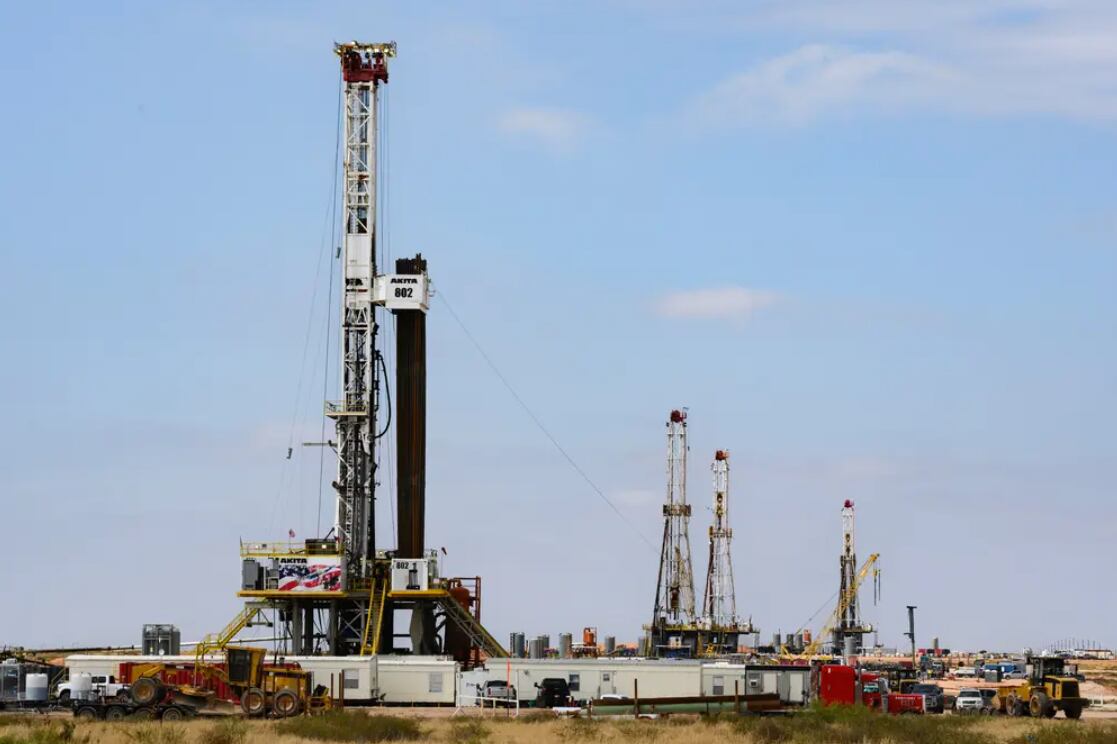Donald Trump’s promise to “drill, baby, drill” probably won’t change much — least of all in Texas
“Donald Trump’s promise to “drill, baby, drill” probably won’t change much — least of all in Texas” was first published by The Texas Tribune, a nonprofit, nonpartisan media organization that informs Texans — and engages with them — about public policy, politics, government and statewide issues.
ODESSA — Former President Donald Trump has vowed to “drill, baby, drill” on Day One of his next administration. He wants, as his website says, for the U.S. to be “the dominant energy producer in the world, by far!”
It already is — thanks to Texas.
Earlier this year, the state’s leading oil and gas association reported that Texas supplied 42% of the nation’s oil in 2023. Texas broke records last year when operators drilled nearly 2 billion barrels of oil and 12 trillion cubic feet of natural gas.
And it was a banner year for oil and gas across the U.S., which produced 12.9 million barrels of oil per day. The previous record was 12.3 million barrels of oil per day in 2019. Already, the federal Energy Information Administration is projecting companies will produce on average 13.2 million barrels per day this year and 13.7 million barrels per day in 2025.
No other country comes close to producing the amount of oil the United States does.
Russia, the world’s second-largest producer, estimated about 9 million barrels a day in June. This wasn’t always the case. During the 1990s and early 2000s, the U.S. trailed Saudia Arabia and Russia. The U.S. took the lead in 2018.
According to industry analysts Texas is again poised to contribute billions of gallons of oil this year. And next. And the one after at. A number of factors influence how much oil and gas companies should supply at any given point to meet demand, but there is no doubt that the industry is teeming with liquid oil, the analysts say. And while Trump might be encouraging more drilling, it is the market, not the person in the Oval Office who sets production standards.
However, the industry would welcome less regulation, which would be more likely in any Republican administration.
The Biden administration orchestrated efforts to combat climate change, including federal rules to lessen methane emissions, blocking nearly half a million acres of federal land in Alaska from drilling, temporarily pausing exports of liquefied natural gas and listing a desert lizard as endangered to protect it from extinction — neither of which has significantly impacted production, analysts say.
Still, they have been enough to sour the relationship with the oil and gas industry, which has said the policies harm production and argued it wants a seat at the policy-crafting table. In contrast, Trump has pledged to eliminate any roadblocks to drilling.
Texas is drilling record amount of oil thanks to fracking and horizontal drilling
Most of the state’s oil comes from the Permian Basin, a 75,000-square-mile area straddling Texas and New Mexico where the biggest names in the energy industry — including Chevron, ExxonMobil and ConocoPhillips — are drilling.
Texas’s share of the Permian Basin is owned by the state and private property owners, according to the Federal Reserve Bank of Dallas. Federal restrictions on drilling would mostly affect New Mexico, where half of production occurring on its soil is federally owned.
Those companies and countless others pumped more oil in 2023 than the nine top-producing states in the nation combined, data by Texas 2036 showed. Drillers extracted 2 billion barrels of oil. The other states, which include Pennsylvania, New Mexico, Oklahoma and North Dakota, pumped about 1.8 billion barrels.
“The sheer magnitude of oil and gas production coming out of Texas is off the charts,” said Jeremy Mazur, a senior policy adviser with Texas 2036.
There is no slowdown in sight. So far this year, the state’s oil and gas regulator approved about 4,500 new drilling permits as of August. That’s about 70 percent of the permits the Railroad Commission of Texas approved last year, which was roughly 6,400.
To drill in Texas, companies must first seek approval from the commission, which has 46 days to approve an application. There is no federal law that limits how many applications the commission may approve.
Texas’s most recent oil boom has been made possible due to technological advances in fracking and horizontal drilling, not a shift in law. Mazur said that a horizontal drilling boom in 2019, in which rigs drill further in distance rather than depth, allowed operators to access more oil without needing as many wells.
Those advances come at a time when energy both domestically and internationally is soaring. And the rising demand for artificial intelligence computing will only add to it.
“There’s a whole global market out there, and there are substantial demands for energy, and Texas has the natural resources in the form of oil and natural gas to supply these commodities to an international market that’s demanding them,” Mazur said.
Supply and demand, not the president, will drive oil and gas production
James Coleman, a professor of law and senior fellow at the American Enterprise Institute, said Trump’s pledge to “drill, baby, drill” is not policy, but political rhetoric meant to excite his base.
“We get sound bites from presidential campaigns and often it’s hard to know what that actually means in practice,” he said. “My sense is that people perceive it as a positive message, and they’re thinking that means more jobs [and] more infrastructure.”
In fact, the idea of drilling more pits consumers’ interests against the oil and gas industry, cutting into their profit from crude oil.
He said the message is still encouraging for the oil and gas industry, as it reinforces its role in the U.S. as the primary source supporting energy demand. It also leaves unanswered questions about the need for infrastructure that supports the current pace of production.
“If drill baby drill or whatever also means build baby build, then there’s pretty widespread benefits, both to producers and consumers,” he said,
Like all commodities, the oil and gas industry pays close attention to supply and demand. And demand for energy is at an all-time high.
However, Jason Feit, an adviser with the energy analytics firm Enverus, said operators are grappling with an excess of natural gas. This fossil fuel is a byproduct of drilling in the vast deposits of the Permian Basin — and, every day, it’s costing operators money.
Companies that explore and drill for oil typically rely on pipelines to transport the natural gas out of the oil fields and into the hands of consumers. In Texas, the hundreds of thousands of miles of pipe transporting billions of cubic feet of natural gas a day don’t have enough space to carry more.
Feit said that, unlike federal pipelines, Texas companies transporting natural gas are not required to publicly disclose how much natural gas they transport. So Enverus uses a combination of extensive industry research and trading data that monitors the price of natural gas to analyze industry trends instead.
Oil and gas companies are paying other companies to take the gas away, Feit said.
According to the New York Times, the price of natural gas in West Texas traded at 85 cents below zero. The price of oil per barrel is $75, high enough for operators to offset the economic loss spurred by the abundance of natural gas, reporting from the Times found.
“‘Drill, baby, drill’ is not messaging that is in the best interest of the industry, in my opinion, as it conveys the promotion of an action without considering the consequences,” Feit said. “I believe that the U.S. should and will continue to increase its production levels for many years to come but with more due diligence than is exemplified by the phrase ‘drill, baby, drill.’”
He said it is rare for the industry to completely satisfy consumer demand.
“There are many variables… there are just too many moving pieces that influence supply and demand. ” Feit said. “So yes, demand gets satisfied, and the market has enough oil but then something changes, and demand changes so more oil is needed, then less oil.”
The Trump campaign did not respond to questions from The Texas Tribune.
Ed Longanecker, president of the Texas Independent Producers and Royalty Owners Association, said operators aren’t keen to drill as much as they have despite calls for more. Drillers are responsive to the market, he said, but added the industry has called for less regulation.
Trump promised oil companies he would undo federal environmental regulation in exchange for a billion dollars in donations, according to Politico.
Longenecker said companies should focus on investing in technology, like equipment that can frack multiple wells at once, and on finding skilled workers. He said that shareholders are less interested in continuing to drill at the current speed.
“The metric for success among many prominent producers changed years ago,” Longenecker said.
The American Petroleum Institute said in a statement that the U.S. is “the envy of the world,” but that “we need the right policies in place to strengthen this energy advantage.”
Disclosure: Exxon Mobil Corporation, Politico, Texas 2036 and New York Times have been financial supporters of The Texas Tribune, a nonprofit, nonpartisan news organization that is funded in part by donations from members, foundations and corporate sponsors. Financial supporters play no role in the Tribune’s journalism. Find a complete list of them here.
This article originally appeared in The Texas Tribune at https://www.texastribune.org/2024/08/15/donald-trump-energy-policy-fact-check-election-2024/.
The Texas Tribune is a member-supported, nonpartisan newsroom informing and engaging Texans on state politics and policy. Learn more at texastribune.org.







